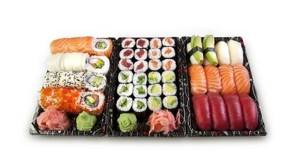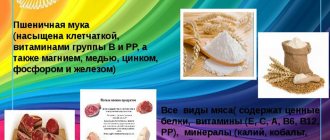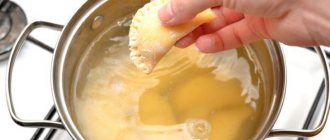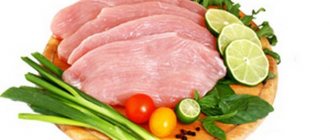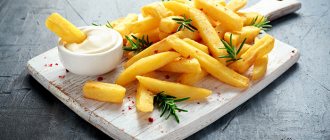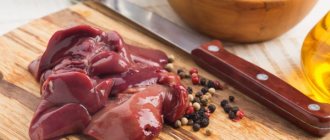Chemical composition of Philadelphia rolls
The chemical composition of Philadelphia rolls depends on the components used.
The table shows an analysis of rolls with the following ingredients:
- nori;
- Philadelphia cheese;
- rice for rolls;
- lightly salted salmon;
- avocado.
| Average daily value, mg | Amount per 100 g serving, mg | |
| Vitamins | ||
| A | 900 mcg | 14.3 mcg |
| IN 1 | 1.2 | 0.07 |
| AT 2 | 1.3 | 0.152 |
| AT 3 | 16 | 0.45 |
| AT 4 | 500 | 20.98 |
| AT 5 | 5 | 0.98 |
| AT 6 | 1.3 | 0.29 |
| AT 9 | 400 mcg | 32.4 mcg |
| AT 12 | 3 mcg | 1.07 mcg |
| WITH | 90 | 2.38 |
| D | 10 mcg | 2.78 mcg |
| E | 14.6 | 1.08 |
| TO | 120 mcg | 4.02 mcg |
| PP | 20 | 2.72 |
| Minerals | ||
| Ca | 1000 | 109.87 |
| Fe | 10 | 0.91 |
| Mg | 400 | 29 |
| Ph | 700 | 220 |
| K | 2500 | 229.49 |
| Na | 1300 | 1004 |
| Zn | 11 | 0.89 |
| Cu | 1000 mcg | 138 mcg |
| Mn | 2.3 | 0.111 |
| Se | 55 mcg | 12.9 mcg |
| Cl | 2300 | 1220 |
| I | 150 mcg | 13.63 mcg |
| Co | 10 mcg | 5.45 mcg |
| F | 4000 mcg | 117.27 mcg |
| Cr | 50 mcg | 15 mcg |
The benefits and harms of the dish
Positive and negative properties are formed based on the composition of the dish.
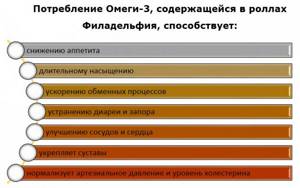
| Ingredient | Beneficial features | Harm and possible contraindications |
| Nori |
| Excessive consumption of nori in food can lead to an excess of iodine. |
| White rice (glutinous) |
| Failure to comply with the norm can lead to:
|
| Lightly salted salmon | The high content of Omega-3 and -6 fatty acids (4.1 g and 0.9 g per 100 g) has the following positive effects:
Collagen in the composition increases the elasticity of the skin. |
|
| Philadelphia cheese |
|
|
| Avocado | As a result of the research, the following beneficial properties of avocado were identified:
| Due to its high calorie content, the product should be used with caution by overweight people. |
| Cucumber |
| Abuse of the product can lead to digestive system disorders and edema. |
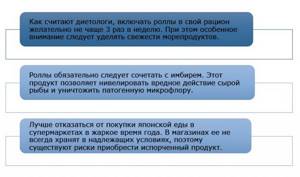
Including Philadelphia rolls in the menu in moderation and subject to certain preparation rules can be beneficial to the body. People with diseases of the gallbladder, gastrointestinal tract, or stomach ulcers (especially during exacerbations) should avoid eating rolls. Overeating can cause constipation or allergies to certain ingredients.
Dietary properties:
How many calories are in Philadelphia rolls, what dietary properties they have, all this is of great interest to those who lead a healthy lifestyle and watch their figure. So we will try to answer these questions in the next article.
So here it is:
Recently, a dish such as rolls has begun to gain increasing popularity among consumers. This product is not to everyone's taste.
You need to feel and understand its unique taste qualities.
Rolls are a type of sushi rolled into sausages. The filling is rice with pressed seaweed, then cut into slices. These slices are called rolls. The dish is prepared using a bamboo mat, or makisu.
For many of us, they still remain a “mystery dish”. Some people don’t like the ingredients they include, others don’t like the way they are prepared. Some people just don't like seafood. But, in any case, this dish is becoming more and more popular.
So, it’s no secret that many dishes of Chinese (and oriental) cuisine in general are very healthy and low in calories. True, the birthplace of this dish is the USA, but it comes from an oriental dish - sushi. Philadelphia rolls get their name from the cheese of the same name, which is part of this product.
One serving of rolls – 6 pieces. And for many this is enough to feel full. The nutritional value of this dish is largely due to the rice, which is added during their preparation.
If you eat 3-4 rolls a day, this will not affect your body weight. If you eat more without reducing the amount of flour and fatty foods in your diet, your body weight may increase.
This dish will be useful for those who suffer from a lack of animal fats, proteins, vitamins and minerals in their food, and with low nutrition. Cheese is a rich source of calcium and phosphorus, so this product is recommended for people susceptible to osteoporosis, fractures, as well as for children with rachitic conditions. Rice contains a number of useful minerals, especially potassium, phosphorus, and magnesium. It is also rich in vitamins - B2 and PP.
However, we should not forget that the beneficial properties and relatively low calorie content of this dish do not deprive this product of some contraindications. For example, it is not recommended for people with diabetes, atherosclerosis, kidney and liver diseases and diseases of the pancreas, stomach and bile ducts.
This dish contains fat-soluble vitamins, chemical elements, cholesterol, vegetable and animal fats, proteins, and carbohydrates. It is recommended for children over 5 years old (but in limited quantities).
Calorie analysis
The table shows a list of the products most commonly used for making rolls and their calorie content.
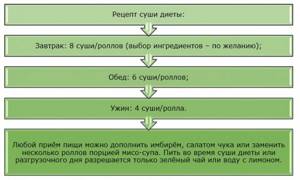
| Ingredient | Calorie content 100 g, kcal |
| White rice for rolls (dry) | 370 |
| Lightly salted salmon | 202 |
| Philadelphia cheese | 342 |
| Smoked eel | 326 |
| Nori | 35 |
| Avocado | 160 |
| Cucumber | 14 |
| Tamago (egg omelette) | 154 |
| Sesame | 565 |
| Soy sauce | 60 |
| Wasabi | 292 |
| Pickled ginger | 20 |
| Rice vinegar | 54 |
| Tabasco sauce with hot peppers | 12 |
| Unagi sauce | 250 |
What determines the calorie content of Philadelphia rolls?
Calorie content depends on the cooking method. For example, the most high-calorie foods are baked rolls and tempura. The latter are deep-fried in batter with a lot of oil. A 100 g serving of such rolls can contain about 200 kcal, baked – 270 kcal.
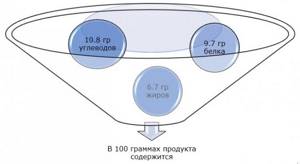
A dish with brown rice would be healthier. Despite the fact that the calorie content of the products is identical, brown rice contains more fiber (3.5 g, white - 2.8 g) and protein (7.6 g, white - 6.8 g).
The main component of rolls, white polished rice, can be the main reason for weight gain.
Brown rice undergoes minimal processing, as a result of which the beneficial substances are preserved in almost complete volume. In the process of grinding white rice, the husk, a source of valuable substances, is removed. The calorie content of a serving will increase if you add sauce to it. One of the most high-calorie sauces is Unagi, which is high in sugar.
100 g of Philadelphia cream cheese will add up to 342 kcal to the dish. To reduce the energy value of rolls, you can replace this cheese with less calories, for example, Creme Bonjour (270 kcal) or curd Almette (216 kcal). It is important to consider that the fat content in 100 g of these cheeses reaches 44-45%.
The most dietary option would be to use low-fat soft cottage cheese (37 kcal), to which greens are added to improve taste. Including fresh vegetables and herbs in the rolls will help reduce calories and increase the amount of fiber. Rolls with vegetables and herbs without adding rice will bring more benefits.
What are the advantages of Japanese cuisine
- The Japanese philosophy involves maximum trust in nature and immersion in it. Therefore, sushi is usually created based on natural products.
- A harmonious combination of ingredients is an important aspect of the exoticism and sophistication of a dish.
- Seasonings allow you to experience the unusual taste and enjoy the peculiarities of Japanese dishes.
- The original design attracts attention, Japanese food looks very aesthetically pleasing and arouses interest and a desire to try amazing dishes.
The energy value of sushi is so low that you can spend a fasting day on this dish.
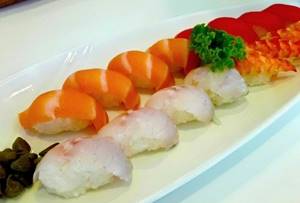
Energy value
Philadelphia rolls, whose calorie content can reach 176 kcal, have an average serving weight of 250 g. Thus, the weight of 1 piece, depending on the cutting method, is 32 or 42 g.
1 roll
The table shows the calorie content of 1 piece. rolls weighing about 42 g.
| 1 PC. (42 g) | Classic, kcal | Dietary option, kcal |
| Rolls according to Dukan | 42 | |
| With avocado and tuna | 57.2 | 43 |
| With cucumber and salmon | 69 | 46 |
| With crab and sesame | 67.5 | 52 |
| Baked rolls with vegetables and eel | 110 | 102 |
Serves 6-8 rolls
Below is an analysis of the calorie content of a serving of 6-8 rolls, with a total weight of 250 g.
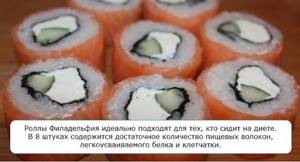
Philadelphia rolls, the calorie content of which depends on the ingredients in the composition, can have a beneficial effect on the body or cause harm.
| 6-8 pcs. (250 g) | Classic, kcal | Dietary option, kcal |
| Rolls according to Dukan | 250 | |
| With avocado and tuna | 343 | 258 |
| With cucumber and salmon | 414 | 276 |
| With crab and sesame | 405 | 312 |
| Baked rolls with vegetables and eel | 660 | 612 |
Per 100 g
The table shows the caloric content of 100 g serving of rolls.
| 100 g | Classic, kcal | Dietary option, kcal |
| Rolls according to Dukan | 100 | |
| With avocado and tuna | 136 | 102 |
| With cucumber and salmon | 164 | 109 |
| With crab and sesame | 160 | 123 |
| Shrimp roll | 383 | 140 |
| Baked rolls with vegetables and eel | 262 | 243 |
Contraindications for use
- Don't get carried away with Japanese cuisine. It is quite unique, so one day a week is enough when you include one or two rolls in your diet, such as Philadelphia, California, Alaska or sushi, the basis of which is seaweed and vegetables, for example, a roll with cucumber.
- You should be very careful with raw fish. If you decide to prepare the dish yourself at home, make sure that all ingredients are fresh.
- Sushi has a very short shelf life, so when ordering it at a restaurant, check how long ago the dish was prepared. When making them at home, it is better not to put them in the refrigerator, but to eat them freshly prepared.

Is it possible to eat sushi while losing weight?
When losing weight, you can eat rolls, taking into account the recommendations for reducing the calorie content of the dish:
- you need to avoid eating baked rolls and tempura; in terms of calorie content and harmful properties, they are similar to fast food;
- you should completely abandon rice, or periodically add brown rice to the dish instead of white;
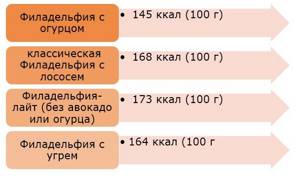
- the amount of brown rice consumed should also be limited;
- rice retains water and produces a strengthening effect;
- salty, sweet and sour sauces slow down the process of removing fluid from the body and increase appetite;
- when choosing soy sauce, you should choose a naturally fermented sauce without the use of wheat;
- Reduced sodium soy sauce contains 25% less salt;
- pickled ginger is prepared with the addition of large amounts of sugar and vinegar, which completely destroys its benefits for weight loss;
- such a product can lead to irritation of the walls of the esophagus;
- mayonnaise (including Japanese) should be avoided;
- Rolls should be washed down with green tea without added sugar;
- green tea is a source of antioxidants;
- it is able to quench thirst after eating salty foods.
What is the benefit
- First of all, it is worth noting that this is a low-calorie food, which may well serve as the basis for a diet.
- The calorie content of Japanese cuisine varies, however, it does not exceed the calorie content of flour products and desserts. That is why restaurants with a similar assortment are more often visited by lovers of healthy food than coffee shops and eateries that offer fast food.
- Rice, seafood and vegetables contain large amounts of microelements that the human body lacks. By eating freshly prepared sushi, you can compensate for the deficiency of fiber, carbohydrates, phosphorus, vitamins and other substances.
Rolls are great for split meals. The volume of one serving is quite small, but they are satisfying and allow you to quickly satisfy your hunger.
